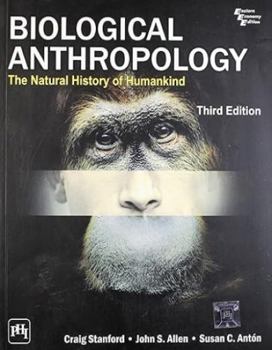Biological Anthropology
Select Format
Select Condition 
Book Overview
NOTE: Before purchasing, check with your instructor to ensure you select the correct ISBN. Several versions of Pearson's MyLab & Mastering products exist for each title, and registrations are not... This description may be from another edition of this product.
Format:Paperback
Language:English
ISBN:8120344480
ISBN13:9788120344488
Release Date:January 2011
Publisher:Pearson
Length:640 Pages
Weight:2.65 lbs.
Customer Reviews
5 ratings
Great quality
Published by Thriftbooks.com User , 14 years ago
The book is in perfect condition and shipped in decent time. I'd recommend this seller to others.
Excellent textbook
Published by Thriftbooks.com User , 14 years ago
This book was used for my Intro to Human Evolution course. I entered the subject with very little prior knowledge and am now leaving majoring in it. This book is not too difficult to read and covers a lot of information in an interesting and thorough manner. Not only did I learn a lot from reading this text, but I also enjoyed it. It was very accessible with out being dummied down. There's a lot of interesting articles within the book about specific topics within each unit. I would highly recommend this.
Book
Published by Thriftbooks.com User , 15 years ago
I'm very excited i got this book. I would have had to pay almost $100 for it but since i bought it here i saved a ton. Awesome buy.
The book
Published by Thriftbooks.com User , 15 years ago
The book is in the condition that was promised and got here on time. Thanks
A bit of family history revealed
Published by Thriftbooks.com User , 16 years ago
Although published as a textbook for university students, this volume is an excellent read for anybody wishing to understand the course of evolution. The authors have assembled a wealth of material, organised it in an effective manner and presented it with outstanding prose skill. Lead author Craig Stanford, whose books on primate behaviour are well-known, is joined by neurologist and geneticist John Allen and anthropologist Susan Anton. The trio brings many years of experience to the task of explaining human origins. After a brief introduction explaining what is meant by "Biological Anthropology", the authors provide a fine survey of the basic mechanisms of natural selection - DNA and genetics. Their depiction of how the genome is formed and how that structure builds the elements needed for natural selection to operate is an outstanding brief summary. Using available chemicals, DNA's mechanisms to build cells are explained, supplemented by vivid graphic images. From the process of cell building, the authors move on to show how the completed organism must deal with its environment, which includes other creatures, plant life and climate conditions through adaptation down succeeding generations. The authors describe the various factors leading to producing new species, isolation, elapsed time and new conditions. They also address the issue of how fossils and conditions are recorded in time and how researchers use a variety of techniques to determine age and place. The species of concern, of course, are the primates. The sudden demise of the great reptiles that had ruled the Earth for over 150 million years opened new vistas for the life that survived the catastrophe. Little, fur-bearing creatures moved into niches that allowed rapid change. Many varieties emerged, but noteworthy among them were shrew-sized omnivores. Spreading over the land and forests, some of them developed new traits that would ultimately lead to us. The origin of the primates is lost in the mists of time, compounded by the paucity of fossils and lack of agreement on what typifies a "primate". The earliest proposed species bears the ungainly name of "Plesiadapiforms". The authors describe the traits suggesting these were our earliest ancestors, while explaining what is lacking to establish a firm identity. Each of the points they introduce is enhanced by the contending researchers' arguments over lineage. Once past the vague beginnings, the team offers insights into how ape transformed into human. The physiological trends, such as jaw structure and teeth are outlined. Each of the fossil examples of pre-human hominids is examined critically with the important elements indicating its lineage in the human story assessed. From a lonely skull in a desert to remote caves, creatures that one day would lead to you and me are revealed. At some point, one or more of the ape-like animals stood upright. Demonstrating what a major step this was, with changes in spi




